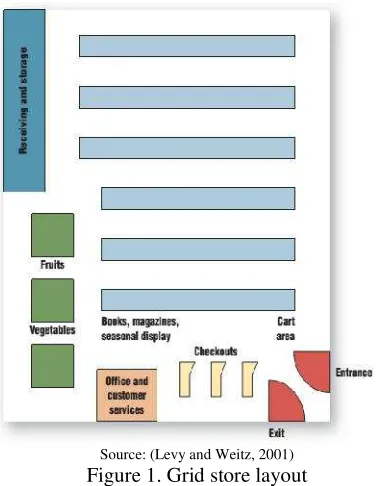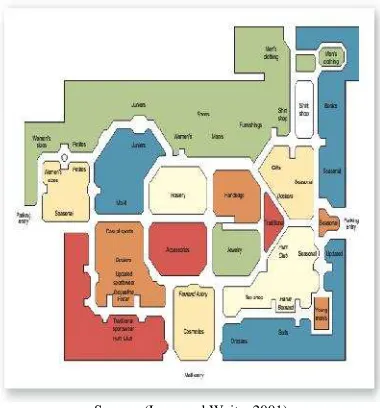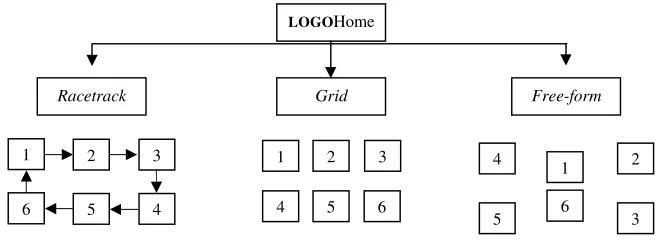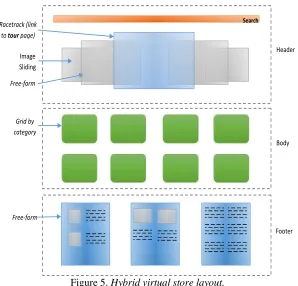A LITERATURE REVIEW
Ilyas Masudin1dan Mukhlish Fuadi2
Abstract: The progress of online shopping worldwide has impacted significantly
to business processes as well as customers’ behavior in shopping. Thus, research
in online retailing especially in virtual store layout has been made by researchers in numerous numbers. This article attempts to explore prior research in virtual layout retails to identify the research in virtual retailing in term of the variables involved in designing the virtual store layout.
Keywords:layout, store, retailing, virtual
INTRODUCTION
Layout strategy is one of the important decisions classified into long term operation strategy in supply chain decisions. An effective and efficient designed layout could impact in competitiveness, process flexibility, costs and also corporate image building (Heizer and Render, 2011). Bazargan-Lari (1999) found that there is significant impact of layout design on costs, wastes and capital investment. An improvement can also be achieved developing an effective layout such as customer satisfaction, labor productivity and delivery time (Heragu and Kusiak, 1988; Hassan, 1995). The most important thing for designing an effective store layout is to provide better customer responsiveness.
Online Retail Layout (ORL) or known as Web-based Store Layout (WSL) is an unique approach in term of allocating space for various products with the objective is to give a better response to customers (Heizer and Render, 2011). The point of ORL is how to show or display products on the space provided online in term of limited space so that the interaction between human (customers) and computers is developed in effective ways for final objective, which are sales and improvement. The impacts of the different type of ORL have been discussed in term of its relations to some aspects such as customer willingness to purchase (Burke, 2002), traffic and sales (Lohse and Spiller, 1998; Huarng and Doris, 2003) and consumer behavior (Siomkos and Vrechopoulos, 2002). In showing the product to customers virtually, most prior research in ORL discussed three different layout such grid, racetrack and free-form which of those three types have different advantages (Levy and Weitz, 2012; Vrechopoulos, 2005; Vrechopoulos et al., 2002). The three conventional ORLs are transformed into web or virtual layouts for computer interfaces over the internet website and then tested on the real customers.
Due to the increasing of customization where each customer has different objectives in visiting store virtually and customers are differentiated by ages, gender and economic levels, while the internet access (fixed and mobile) especially in the
1
Industrial Engineering Department, University of Muhammadiyah Malang Jl. Raya Tlogomas 246 Malang 65144
E-mail :masudin@umm.ac.id
2
developing countries gets better currently, it is important to review prior study in term how the progress of ORL research has been done and how further research should be focused on. Therefore, this paper attempts to explore past works in ORL, particularly on the virtual layout design and the variables and constructs are developed.
LITERATURE REVIEW
Conventional Store Layout Retailing
The strategy in store’s layout has significant implication on customer’s behavior on purchase. The problems to decide a fit layout strategy in store rises due to a limited space availability to display all products to provide excellent customer service. The implications of store layout on customer behavior in purchase in store are exist (Griffith, 2005; Cornelius et al., 2010; Sen et al., 2002). According to Levy & Weitz (2012), store layouts in retailing are conventionally classified into three different layout, grid, freeform and racetrack layouts. Grid store layout is designed for fast shopping activities where customers are supposed to locate and find stuffs easily. The products are displayed on the both sides of parallel aisles of the large extent store’s space based on the certain category so customers can move through the entire store (see figure 1).
Source: (Levy and Weitz, 2001)
Figure 1. Grid store layout
The grid ORL, which is set based on the parallel aisles to one another, is generally used by common groceries for customers who have planned their purchase (Levy and Weitz, 2012, Mason, 1991).The freeform type is set the layout asymmetrically which gives customers to enjoy and free movement. This form which is generally used by fashion stores, leads customers to browse the store and increase the willingness to purchase along the time (Lewison, 1994, Mason, 1991, Levy and Weitz, 2012). Meanwhile, racetrack is arranged aisles based on the themes so that customers will provide an interesting, entertaining and experiencing shopping (Lewison, 1994).
asymmetrically that all different types, size and shapes are displayed in the same sections.
Source: (Levy and Weitz, 2001)
Figure 2. Racetrack store layout
Employing this type allows customers to move and browse stuffs to all directions within the stores (see figure 2) and leads customers to increase their willing to purchase stuffs instead of their shopping lists due to spend longer time in the store. Most large department stores as fashion stores are applying this layout type. In racetrack store layout, the floor is modeled into separated areas based on the same particular stuff’s theme (see figure 3). In this type, customers can move along the stores’ sections because this layout is designed to facilitate them to visit as many as store’s sections. This store layout gives a different and interesting shopping experience to customers (Lewison, 1994).
Source: (Levy and Weitz, 2001)
Table 1. Previous works in online store layout
A significant growths of World Wide Web and internet users have impacted on online business especially on the business to customers (B2C). The increase of internet users worldwide which reached 361.9 million in 2003 (Yorgey, 2000) has created opportunities for this electronic business by transforming all conventional activities within business processes to electronic activities. One of the promised online businesses which use internet is retailing. It is reported that E-shopping has valued up to US$ 500 billion by 2002 (Teo, 2002). Virtual retailers recently use internet not only for display purposes but also for other functions as ordering process and online purchasing process. Moreover, for a big corporate point of view, the concept of virtual store might become the solution to minimize the costs of supply chain management from the long channel of supply by cutting function of the “real” retailing stores and replacing it into virtual store. It is investigated that by online selling strategy in the multi echelon supply chain business impact on pricing and ordering decisions, which are reducing costs of supply chain (Hsieh et al., 2014). Moreover, virtual store layout decisions is potentially giving customers more information needed about the stores and developing customers’ elaboration and response the other products or brands. Griffith (2005) found that different ORL gives different results in the level of customers’ elaboration and customers’ outcome.
There are also some discussions of ORL applications and its implications in customers’ behavior. It is investigated that the virtual store layout influences planned customers behavior (Kollat and Willett, 1967, Seiders et al., 2000). For example, for customers who have routine and planned behavior in shopping in the particular stores, grid virtual store layout facilitates is better ORL than others because they could do pre-selection the stuffs before purchasing (Lewison, 1994, Ghosh, 1994, Levy and Weitz, 2012). Prior study about racetrack ORL indicated that it is the most entertaining conventional ORL for customers for purchasing the stuffs via internet is racetrack, therefore this type leads customers to spend more time in the store for shopping (Herrington and Capella, 1995, Donovan et al., 1994). Further previous study also indicates that more time spent by customers for browsing the store by online using this type of ORL (Eroglu et al., 2001, Li et al., 1999, van der Heijden, 2003). The same phenomena in the freeform ORL that customers are willing to spend more time in the store for shopping due to enjoy the freedom of move within the store.
for their online store. The detail of the applications of online layout store are shown by table 2.
Table 2 The application of online store layout
No Layout Applications
1. Grid www. safeway co.uk, www. Sainsburry.co.uk 2. Racetrack www.foodonline.co.uk, www.simplyorganic.net 3. Freeform www.smartbuy.gr, www.homenet.gr
Source: Vrechopoulos et al. (2004)
Hybrid Online Retail Layout (HORL)
Besides the conventional online store layout, to accommodate the disadvantages of applying OSL mentioned previously, a progressive online layouts are required. One of them is called hybrid online retail layout (HORL), which is developed by accommodating each function of conventional store layout. HORL allows customers to choose accessing the stuffs within the store in three different ways based on the customers’ needs. The structure of HORL is shownin figure 4.
Figure 4. Website structure forhybrid layout.
The HORL is structured based on the three conventional ORL’s functions, for example, racetrack type in HORL is provided for customers who have not long enough time to browse the stuffs within store, while grid type is provided in HORL for customers who want to buy planned purchase and Free-form layout is covered for customers who have not plan to purchase while having a limited time in the store. The characteristics of three conventional store layouts on the customers’ purposes are shown in table 3.
Table 3. Characteristics of conventional VSL
Type Purpose Planned Time
Grid Purchase Yes Short
Racetrack Browsing No Long
Free-form Browsing & plan to purchase No Medium
In HORL website, the display of three conventional store layouts can be performed in particular form and places. We divided the main structure of website into three, a header column for the main contents or even more in the middle while sidebars are put on the sides of the website. In this research, we display racetrack layout on the header, grid layout on the main content and free form on the sidebar or footer. For attracting customers to visit HORL, interactive technology on the
LOGOHome Page
Grid
Racetrack Free-form
1 2 3
6 5 4
1 2 3
4 5 6
4 1 2
designed website can be added as Image Interactive Technology (IIT) or sliding image, interactive image (zoom-in functions) and 3D virtual model (Kim et al., 2007).
Figure 5.Hybrid virtual store layout.
The proposed hybrid store layout in this research puts freeform layout on the header with image sliding which guides customers to other type of layout, racetrack. The reason that Racetrack use with this way is because they are assumed having long time spent within the store. Free-form layout in this proposed HORL is displayed on the footer and header, while grid layout is put on the main page position that consist of more detail information of stuffs when clicked. For customers who have a limited time in shopping can use search menu. The expectation of applying HORL are accommodating three conventional store layouts, giving a better experience in shopping and providing better customer service.
Approached Variables for ORL
Prior research about conventional store layout indicates that there is a relationship between virtual store layout and customer behavior. The impacts of virtual grid, freeform and racetrack layout has been tested to investigate the relation to customer behavior in Vrechopolous (2002). This research uses variables adopted by Vrechopolous (2002) that the measures customers behavior on different conventional ORL can be approached with “facilitating planned purchase (a), easy navigation within store (b), perceived entertainment (c), time spent within store (d) and website information style (e)” to test whether and how the proposed virtual store layout (hybrid online retail layout - HORL) affects customers behavior in those terms of constructs. The use of first and second constructs this research are based on the theory of Technology Acceptance Model (TAM) which were developed by Davis (1989), while the third construct followed the model from Lastovicka (1983) and
Header
Body
Footer Image
Sliding
Grid by category
Free-form Free-form Racetrack (link
totourpage)
Vrechopoulos, O’Keefe, Doukidis, & Siomkos (2004), then the complexity of information given by the website to customers is presented by website information style (Verhagen and van Dolen, 2011) and fourth construct is automatically measured by the system. customer’s information gathering. The research has been done shows that conventional online retail layout (ORL) are the most layout for online store used by most online groceries or department store. From the literature review in this paper, it is shown that the use of online store layout has influenced the customers’ perceived. It is believed that the three conventional online store layout such as grid, freeform and racetrack has relationship with the customers’ perceived in different ways as customers’ time spent in the website, the willingness to purchase, freedom to move on the website and the level of entertainment.
For customization reasons, it is believed that there should be an accommodative online store layout for customers so that other unsatisfied customers’ perceived as shown in the conventional layout variables can be reached. Thus, an hybrid online retail layout (HORL) which combines all the functions of conventional online layouts, are important to discuss for further research.
References
Bazargan-Lari, M. 1999. “Layout designs in cellular manufacturing”.European Journal of Operational Research. Vol. 112, pp. 258-272.
Burke, R. 2002. “Technology and the customer interface: What consumers want in the physical and virtual store”.Journal of the Academy of Marketing Science. Vol. 30, pp. 411-432.
Cornelius, B.; Natter, M.; & Faure, C. 2010.“How storefront displays influence retail store image”.Journal of Retailing and Consumer Services. Vol. 17, pp. 143-151.
Davis, F. D. 1989.“Perceived Usefulness, Perceived Ease of Use, and User Acceptance of Information Technology”.MIS Quarterly. Vol. 13, pp. 319-340.
Donovan, R. J.; Rossiter, J. R.; Marcoolyn, G.; & Nesdale, A. 1994.“Store atmosphere and purchasing behavior”.Journal of retailing. Vol. 70, pp. 283-294.
Eroglu, S. A.; Machleit, K. A.; & Davis, L. M. 2001. “Atmospheric qualities of online retailing: A conceptual model and implications”.Journal of Business Research. Vol. 54, pp. 177-184.
Ghosh, A. 1994.Retail Management. Dryden Press.
Griffith, D. A. 2005. “An examination of the influences of store layout in online retailing”.
Hassan, M. M. D. 1995. “Layout design in group technology manufacturing”. International Journal of Production Economics. Vol. 38, pp. 173-188.
Heizer, J.; & Render, B. 2011.Operations Management. New Jersey: Pearson Education, Inc. Heragu, S. S.; & Kusiak, A. 1988. “Machine Layout Problem in Flexible Manufacturing
Systems”. Operations Research. Vol. 36, pp. 258-268.
Herrington, J. D.; & Capella, L. M. 1995. “Shopper reactions to perceived time pressure”.
International Journal of Retail & Distribution Management. Vol. 23, pp. 13-20.
Hsieh, C.-C.; Chang, Y.-L.; & Wu, C.-H. 2014.“Competitive pricing and ordering decisions in a multiple-channel supply chain”. International Journal of Production Economics. Vol. 154, pp. 156-165.
Huarng, A. S.; & Doris, C. 2003. “Planning an effective internet retail store”. Marketing Intelligence & Planning. Vol. 21, pp. 230-238.
Kim, J.; Fiore, A. M.; & Lee, H.-H. 2007. “Influences of online store perception, shopping enjoyment, and shopping involvement on consumer patronage behavior towards an online retailer”.Journal of Retailing and Consumer Services. Vol. 14, pp. 95-107. Kollat, T. D.; & Willett, P. R. 1967. “Customer Impulse Purchasing Behavior”. Journal of
Marketing Research. Vol. 4, pp. 21-31.
Lastovicka, J. L. 1983.“Convergent and discriminant validity of television commercial rating
scales”.Journal of Advertising. Vol. 12, pp. 14-52.
Levy, M.; & Weitz, B. A. 2001.Retailing Management. New York: McGraw Hill. ----. 2012.Retailing Management. New York: McGraw-Hill.
Lewison, D. M. 1994.Retailing. New York: Macmillan College Publishing Company. Li, H.; Kuo, C.; & Russell, M. G. 1999.“The impact of perceived channel utilities, shopping
orientations, and demographics on the consumer's online buying behavior”. Journal of Computer-Mediated Communication. Vol. 5 (2), pp. 0-0.
Lohse, G. L.; & Spiller, P. 1998.“Electronic shopping”.Communications of the ACM. Vol. 41, pp. 81-87.
Mason, B. J.; Mayer, M. L.; & Ezell, H. F. 1991.Retailing. Boston: Irwin.
Seiders, K.; Berry, L. L.; & Gresham, L. G. 2000.“Attention, retailers! How convenient is your convenience strategy?”Sloan Management Review. Vol. 41, pp. 79-90.
Sen, S.; Block, L. G.; & Chandran, S. 2002. “Window displays and consumer shopping decisions.”Journal of Retailing and Consumer Services. Vol. 9, pp. 277-290.
Siomkos, G. J.; & Vrechopoulos, A. P. 2002.“Strategic marketing planning for competitive advantage in electronic commerce.”International Journal of Services, Technology and Management. Vol. 3, pp. 22-38.
Teo, T.S.H. 2002. “Attitudes toward online shopping and the Internet.” Behaviour & Information Technology. Vol. 21, pp. 259-271.
Van der Heijden, H. 2003.“Factors influencing the usage of websites: the case of a generic portal in The Netherlands.”Information & Management. Vol. 40, pp. 541-549.
Verhagen, T.; & Van Dolen, W. 2011. “The influence of online store beliefs on consumer online impulse buying: A model and empirical application.” Information & Management. Vol. 48, pp. 320-327.
Vrechopoulos, A. 2005. “Designing Alternative Store Layouts for Internet Retailing.” In: Doukidis, G.; & Vrechopoulos, A. (eds.) Consumer Driven Electronic Transformation. Springer Berlin Heidelberg.
Vrechopoulos, A.; Papamichail, G.; & Doukidis, G. 2002. “Identifying Patterns in Internet Retail Store Layouts.”In: Pardalos, P.; & Tsitsiringos, V. (eds.)Financial Engineering, E-commerce and Supply Chain. Springer US.
Vrechopoulos, A.; O’Keefe, R.M.; Doukidis, G.; & Siomkos, G. J. 2004. “Virtual store layout: an experimental comparison in the context of grocery retail.” Journal of Retailing. Vol. 80, pp. 13-22.





